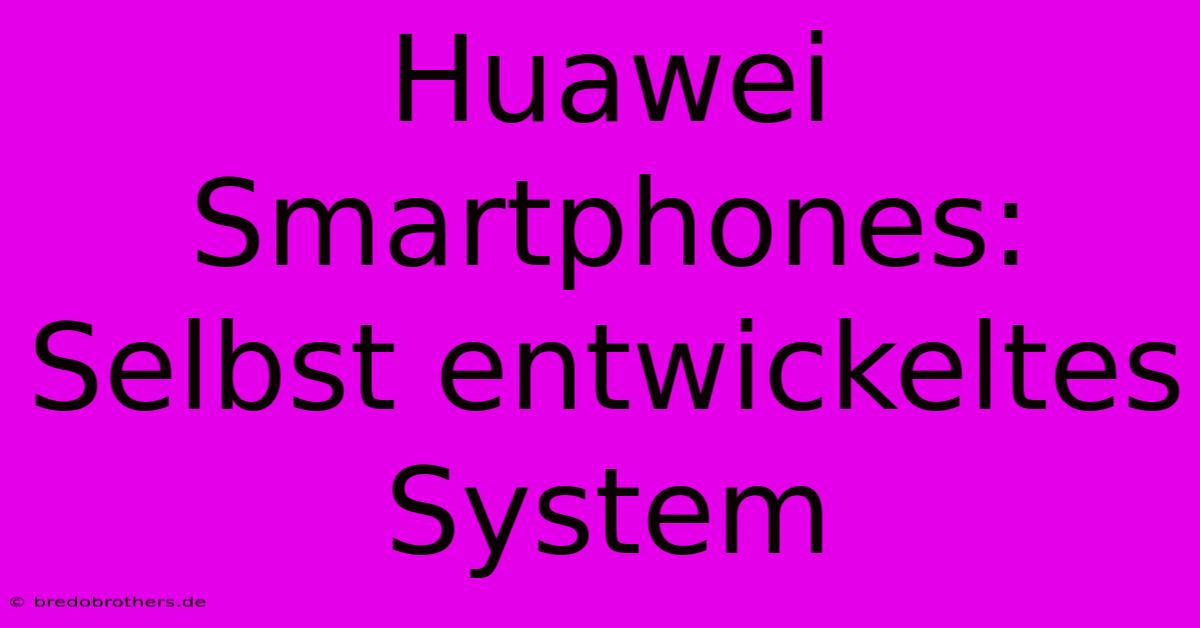Huawei Smartphones: Selbst Entwickeltes System

Discover more detailed and exciting information on our website. Click the link below to start your adventure: Visit Best Website Huawei Smartphones: Selbst Entwickeltes System. Don't miss out!
Table of Contents
Huawei Smartphones: Selbst entwickeltes System – Meine Erfahrungen mit HarmonyOS
Hey Leute! Let's talk Huawei and their own operating system, HarmonyOS. I’ve been a bit of a techie my whole life, always diving headfirst into the latest gadgets. And boy, did I have some feelings when Huawei got hit with those US sanctions. Remember that? It felt like the rug was pulled out from under a whole lotta people who loved their Huawei phones. Suddenly, no more Google services – a total bummer for anyone used to the Google ecosystem.
<h3>Der Sprung ins Ungewisse: Mein erster HarmonyOS-Kontakt</h3>
My first experience with HarmonyOS was… well, let's just say it wasn't love at first sight. I remember getting my hands on a Huawei P50 Pro – a gorgeous phone, no doubt – and feeling completely lost. Where was Gmail? Where was Maps? It was like learning a whole new language. The initial learning curve was steep. I felt like a total noob. I spent hours fiddling with settings, downloading apps from the Huawei AppGallery, and generally cursing my impatience.
It felt incredibly frustrating. I mean, I'm tech-savvy, but navigating a completely new OS without the familiar comfort of Google apps? It was a real challenge. I almost wanted to throw the phone across the room. Almost.
<h3>HarmonyOS: Überraschend gut, aber nicht perfekt</h3>
But, here’s the thing: I stuck with it. And you know what? HarmonyOS grew on me. It’s not a perfect copy of Android, and it'll never be. But it’s actually pretty darn good. It's smooth, intuitive after a while and, dare I say, has some features I actually prefer to Android. The multitasking capabilities, for example, are killer – much better than what I'm used to on Android. I could easily switch between apps and even run multiple apps in split-screen mode – seriously useful for productivity.
<h3>Die AppGallery: Ein wachsendes Ökosystem</h3>
One of my biggest initial concerns was the AppGallery. I worried that I would be missing out on a ton of apps. While it's true that some popular apps are missing – like some banking apps, some game apps and more – it's surprisingly comprehensive. And it's improving all the time. They've gotten a lot smarter about recommending relevant apps. I've found most of the apps I actually use regularly are available. Plus, Huawei's Petal Search helps find apps not directly on the AppGallery. A bit of a workaround, but it gets the job done.
<h3>Praktische Tipps für HarmonyOS-Neulinge</h3>
If you’re thinking about switching to a Huawei phone with HarmonyOS, here's my advice:
- Be patient: It takes time to adjust. Don't expect a seamless transition.
- Explore the AppGallery: You might be surprised by what you find.
- Use Petal Search: It’s a lifesaver for finding apps not available on the AppGallery.
- Check for updates: Huawei is constantly improving HarmonyOS. Keep your system up-to-date!
- Embrace the differences: HarmonyOS has its own strengths. Learn to appreciate them.
So, my journey with HarmonyOS wasn’t exactly straightforward. It started with frustration and ended with pleasant surprise. Huawei's self-developed system isn’t a perfect clone of Android, but it’s a viable, improving alternative. And that's pretty impressive, considering the circumstances. It’s definitely worth checking out, especially if you're looking for a solid, unique mobile experience. What are your thoughts? Let me know in the comments!

Thank you for visiting our website wich cover about Huawei Smartphones: Selbst Entwickeltes System. We hope the information provided has been useful to you. Feel free to contact us if you have any questions or need further assistance. See you next time and dont miss to bookmark.
Featured Posts
-
Ferencvaros Siegt 4 1 Gegen Malmoe Ff
Nov 29, 2024
-
Jelmoli Zuerich Umbau Durch Sps Genehmigt
Nov 29, 2024
-
Aston Villa Juventus Ucl Im Tv Und Live Stream
Nov 29, 2024
-
Siemens Kursziel 220 Euro Bernstein Outperform
Nov 29, 2024
-
Wie Wurde Schmid Kronzeuge Details
Nov 29, 2024
